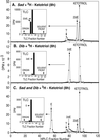Molecular and biochemical characterization of two P450 enzymes in the ecdysteroidogenic pathway of Drosophila melanogaster
- PMID: 12177427
- PMCID: PMC123207
- DOI: 10.1073/pnas.162375799
Molecular and biochemical characterization of two P450 enzymes in the ecdysteroidogenic pathway of Drosophila melanogaster
Abstract
Five different enzymatic activities, catalyzed by both microsomal and mitochondrial cytochrome P450 monooxygenases (CYPs), are strongly implicated in the biosynthesis of ecdysone (E) from cholesterol. However, none of these enzymes have been characterized completely. The present data show that the wild-type genes of two members of the Halloween family of embryonic lethals, disembodied (dib) and shadow (sad), code for mitochondrial cytochromes P450 that mediate the last two hydroxylation reactions in the ecdysteroidogenic pathway in Drosophila, namely the C22- and C2-hydroxylases. When sad (CYP315A1) is transfected into Drosophila S2 cells, the cells metabolize 2-deoxyecdysone (2dE) to E and the [3H]ketotriol (2,22-dideoxyecdysone) to 22-deoxyecdysone. In contrast, dib (CYP302A1) is responsible for the conversion of the [3H]ketotriol to [3H]2dE. When cells are transfected with both dib and sad, they metabolize the [3H]ketotriol to [3H]E in high yield. The expression of sad and dib is concentrated within the individual segments of the developing epidermis when there is a surge of ecdysteroid midway through embryogenesis. This result occurs before the ring gland has developed and suggests that the embryonic epidermis is a site of ecdysteroid biosynthesis. This pattern then diminishes, and, during late embryogenesis, expression of both genes is concentrated in the prothoracic gland cells of the developing ring gland. Expression of dib and sad continues to be localized in this endocrine compartment during larval development, being maximal in both the late second and third instar larvae, about the time of the premolt peaks in the ecdysteroid titer.
Figures




Similar articles
-
Halloween genes encode P450 enzymes that mediate steroid hormone biosynthesis in Drosophila melanogaster.Mol Cell Endocrinol. 2004 Feb 27;215(1-2):1-10. doi: 10.1016/j.mce.2003.11.003. Mol Cell Endocrinol. 2004. PMID: 15026169 Review.
-
Phantom encodes the 25-hydroxylase of Drosophila melanogaster and Bombyx mori: a P450 enzyme critical in ecdysone biosynthesis.Insect Biochem Mol Biol. 2004 Sep;34(9):991-1010. doi: 10.1016/j.ibmb.2004.06.009. Insect Biochem Mol Biol. 2004. PMID: 15350618
-
The Drosophila disembodied gene controls late embryonic morphogenesis and codes for a cytochrome P450 enzyme that regulates embryonic ecdysone levels.Development. 2000 Oct;127(19):4115-26. doi: 10.1242/dev.127.19.4115. Development. 2000. PMID: 10976044
-
CYP306A1, a cytochrome P450 enzyme, is essential for ecdysteroid biosynthesis in the prothoracic glands of Bombyx and Drosophila.J Biol Chem. 2004 Aug 20;279(34):35942-9. doi: 10.1074/jbc.M404514200. Epub 2004 Jun 14. J Biol Chem. 2004. PMID: 15197185
-
The Halloween genes code for cytochrome P450 enzymes mediating synthesis of the insect moulting hormone.Biochem Soc Trans. 2006 Dec;34(Pt 6):1256-60. doi: 10.1042/BST0341256. Biochem Soc Trans. 2006. PMID: 17073797 Review.
Cited by
-
Analysis of the transcriptomes downstream of Eyeless and the Hedgehog, Decapentaplegic and Notch signaling pathways in Drosophila melanogaster.PLoS One. 2012;7(8):e44583. doi: 10.1371/journal.pone.0044583. Epub 2012 Aug 31. PLoS One. 2012. PMID: 22952997 Free PMC article.
-
The insulator protein CTCF regulates Drosophila steroidogenesis.Biol Open. 2015 May 15;4(7):852-7. doi: 10.1242/bio.012344. Biol Open. 2015. PMID: 25979705 Free PMC article.
-
The Wolbachia genome of Brugia malayi: endosymbiont evolution within a human pathogenic nematode.PLoS Biol. 2005 Apr;3(4):e121. doi: 10.1371/journal.pbio.0030121. Epub 2005 Mar 29. PLoS Biol. 2005. PMID: 15780005 Free PMC article.
-
Transcriptomic Analysis Reveals Insect Hormone Biosynthesis Pathway Involved in Desynchronized Development Phenomenon in Hybridized Sibling Species of Tea Geometrids (Ectropis grisescens and Ectropis obliqua).Insects. 2019 Nov 1;10(11):381. doi: 10.3390/insects10110381. Insects. 2019. PMID: 31683768 Free PMC article.
-
Recent progress in understanding the role of ecdysteroids in adult insects: Germline development and circadian clock in the fruit fly Drosophila melanogaster.Zoological Lett. 2015 Nov 2;1:32. doi: 10.1186/s40851-015-0031-2. eCollection 2015. Zoological Lett. 2015. PMID: 26605077 Free PMC article. Review.
References
-
- Gilbert L. I., Rybczynski, R. & Warren, J. T. (2002) Annu. Rev. Entomol. 47, 883-916. - PubMed
-
- Henrich V. C., Rybczynski, R. & Gilbert, L. I. (1999) in Vitamins and Hormones, ed. Litwack, G. (Academic, San Diego), Vol. 55, pp. 73–125. - PubMed
-
- Thummel C. S. (1995) Cell 83, 871-877. - PubMed
-
- Kappler C., Kabbouh, M., Hetru, C., Durst, F. & Hoffmann, J. (1988) J. Steroid Biochem. 31, 891-898. - PubMed
Publication types
MeSH terms
Substances
Grants and funding
LinkOut - more resources
Full Text Sources
Other Literature Sources
Molecular Biology Databases
Miscellaneous

